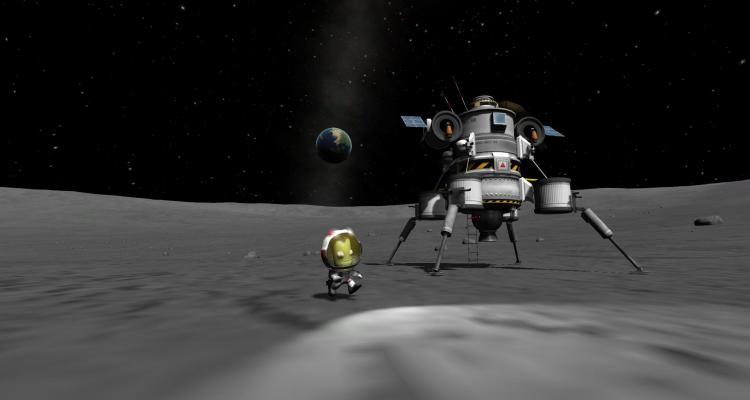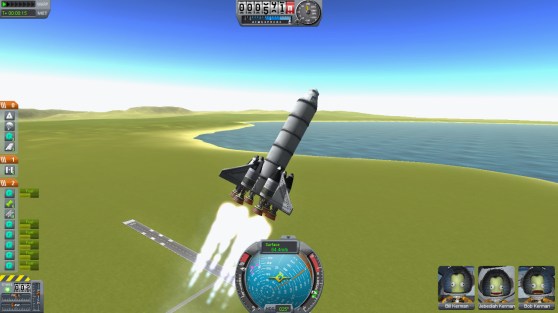The moon is 238,900 miles from the Earth. That’s a great distance, and it’s about how far away Kerbal Space Program creator Felipe Falanghe felt from success when he came up with the idea for his realistic space-shuttle-building game 11 years ago.
Today, Kerbal Space Program has thousands of players and a dedicated, passionate community. The game has players piecing together spacecraft to enter orbit, travel to other planets, and land on virtual moons. Its physics operate under the same rules as reality, and it is not easy. It’s literally rocket science — but instead of acting as barriers to the fun, space-loving gamers flocked to the title exactly because it is such an accurate representation of space travel.
Editor’s note: Developers! If you’re good and want to be great, our upcoming DevBeat conference, Nov. 12-13 in San Francisco, is a hands-on event packed with master classes, presentations, Q&As, and hackathons, all aimed at boosting your code skills, security knowledge, hardware hacking, and career development. Register now.
But Falanghe’s pet project had a long journey from idea to creation to beloved indie game, and the developer wasn’t sure if it would ever find an audience — but as it was with the human race and the moon, so it is with Kerbal Space Program and success.
From the Earth to the top of the neighbor’s house
It started as a game — not a video game, but as one of those imaginative creations of bored teenagers.
“It was just this very dangerous thing that I used to play with my friends with actual fireworks,” Falanghe told GamesBeat. “We’d take them apart and assemble spacecraft, I guess you could call it, with struts and fins. Then we’d make little men out of tin foil and strap them into the cockpits. We called them Kerbals. That’s how the concept was born.”
The idea stuck with Falanghe through his studies at Anhembi Morumbi University in Sao Paulo, Brazil, and then when he joined Internet marketing company Squad in Mexico City.
Squad isn’t a game developer. It provides digital and interactive services to other companies, including creating websites, guerrilla marketing, and corporate-image design. Falanghe toiled away on these project, while continuing to develop the concept for Kerbal Space Program in the back of his mind.
One day, after realizing how open and thoughtful his bosses were, Falanghe decided to pitch the idea of letting him make a game.
“When I told Adrian [Goya] and Ezequiel [Ayarza], who are Squad’s owners, that I wanted to make a video game, they blew me away when they said: ‘Go for it. If you bring us a cool idea and a viable development plan, we’ll go for it.’ That’s how it all got started,” said Falanghe.
A viable plan
“I had no idea how far we could take the project,” said Falanghe. “I had this concept for KSP, but I knew that it would probably have to be something very simple.”
The early days of KSP were much less ambitions. It was originally imagined as a 2D game where players piece together rockets and see how high they could launch them. That was it.
“Then I started having all these other ideas as I wrote the design doc,” he said. “Maybe you could get something if you could land. Maybe you could get into orbit. Maybe you could build a space station. I wrote all that down in a ‘Highly Wishful Set of Features – Maybe One Day’ list, because of the way it got started, we didn’t know how far we could go with the idea.”
Falanghe also wanted a playable game as soon as possible. This forced him and his team to balance his growing wish list with building something concrete in a short amount of time. To solve that issue, Squad settled into a unique workflow.
A self-contained game every three weeks
From the very beginning, Squad didn’t worry about cramming everything into Kerbal Space Program. Instead, Falanghe came up with a three-week development schedule.
“Every three weeks, at the end of each cycle, we have to end up with something that’s playable,” he told GamesBeat. “Even if it wasn’t the full game, it had to be complete in itself. Self-contained.”
The studio still uses this basic method of producing a full, working game on a cycle. It has the base KSP game, and each time it adds new features, it gets them working without bugs before releasing the update.
“We don’t even think of ourselves as being in alpha or beta because each one of our updates has its own alpha and beta life cycle,” said Falanghe.
In the early days of 2011, each cycle was only three weeks. It’s much longer now. Squad realized that it needed more and more time to get complicated additions working correctly.
“Three weeks just isn’t enough time to do significant features with the size the game currently is,” said Falanghe. “We decided, at some point, that we just don’t commit ourselves to a release deadline, at least publicly. We go for it until we feel that it’s done.”


